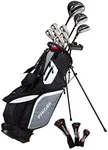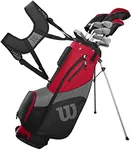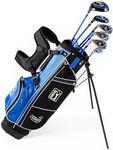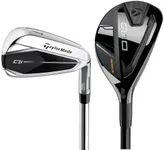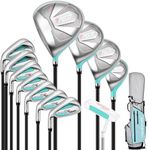Buying Guide for the Best Left Handed Golf Club Sets
Choosing the right left-handed golf club set can significantly improve your game and make your golfing experience more enjoyable. When selecting a set, it's important to consider various specifications that can affect your performance. Understanding these key specs will help you make an informed decision and find the best fit for your needs.Club CompositionClub composition refers to the types of clubs included in the set, such as drivers, woods, irons, wedges, and putters. This is important because different clubs are used for different types of shots. Beginners might prefer a set with more forgiving clubs like hybrids and cavity-back irons, while more experienced players might opt for a set with a wider variety of specialized clubs. Consider your skill level and playing style when choosing the composition of your set.
Shaft MaterialThe shaft material of a golf club can be either steel or graphite. Steel shafts are heavier and provide more control, making them suitable for players with faster swing speeds. Graphite shafts are lighter and can help increase swing speed, which is beneficial for players with slower swing speeds or those looking for more distance. Choose the shaft material that complements your swing speed and desired control.
Shaft FlexShaft flex refers to the amount of bend in the club shaft during a swing. It is important because it affects the accuracy and distance of your shots. Flex options range from extra stiff (X) to ladies (L). Players with faster swing speeds typically benefit from stiffer shafts, while those with slower swing speeds should opt for more flexible shafts. Assess your swing speed to determine the appropriate shaft flex for you.
Club LengthClub length is the measurement from the grip end to the clubhead. It is crucial because it affects your stance and swing mechanics. Standard club lengths are designed for average height players, but if you are significantly taller or shorter, you may need custom-fitted clubs. Ensure the club length allows you to maintain a comfortable and effective posture during your swing.
Clubhead DesignClubhead design includes factors like the size, shape, and weight distribution of the clubhead. Larger clubheads, often called 'game improvement' clubs, offer a larger sweet spot and are more forgiving on off-center hits, making them ideal for beginners. Smaller, 'player's' clubheads provide more control and feedback, preferred by advanced golfers. Choose a clubhead design that matches your skill level and playing style.
Grip SizeGrip size is the thickness of the club's grip and is important for comfort and control. Grips come in standard, midsize, and oversize options. A grip that is too small can cause excessive hand action, while a grip that is too large can restrict wrist movement. Try different grip sizes to find one that feels comfortable and allows you to maintain proper control throughout your swing.
Set ConfigurationSet configuration refers to the specific combination of clubs included in the set. Some sets are designed for beginners and include a variety of forgiving clubs, while others are tailored for advanced players with more specialized clubs. Consider your experience level and the types of courses you play on to determine the best set configuration for you.


